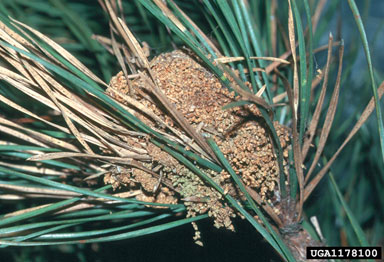Pine webworm
Pococera robustella

Frass entangled in webbing of pine webworm
Photo credit: Connecticut Agricultural Experiment Station Archive, Connecticut Agricultural Experiment Station, Bugwood.org
Natural History
The pine webworm (Pococera robustella) feeds on and lives in pine trees across the eastern United States. It usually chooses young seedlings but can infest saplings and larger trees. The eating habits of the larvae causes a loss of needles but this rarely leads to tree mortality. The defoliation can affect tree growth, especially on very small trees.
Between May and September, adult pine webworm moths mate and lay eggs on the needles of a host tree. The eggs hatch weeks or months later depending on the temperature and season. After the larvae hatch, they construct a mass of silken webbing among the pine needles and deposit solid excrement called frass.
Usually one to two larvae inhabit a single webbing mass but as many as 25 larvae can live in a mass on some occasions. The larvae's main food source is the surrounding pine needles. The larvae mature and then drop to the ground where they pupate underneath the soil, forming an oval cocoon like covering. Again temperature and season determine the amount of time the webworm spends in the pupae stage. When that stage does end, the webworm emerges, transformed into an adult moth.
